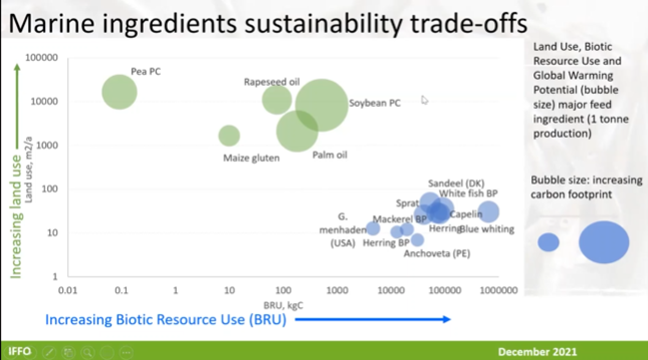The full presentation is here
Key takeaways from the Environmental Impacts InFocus webinar
How do we measure the sustainability of products and their supply chains and how does this measurement apply to aquaculture and marine ingredients? This was the main focus of our inaugural InFocus webinar on 15 December, featuring Dr Richard Newton, of the Institute of Aquaculture, University of Stirling.
What is life cycle assessment (LCA)?
The overall aim is to provide a comprehensive assessment of the full (global) impact of food-production and avoid trade-offs or cross-subsidisations of sectors through incomplete sustainability accounting.
- LCA measures a variety of impacts, like Carbon Footprint (Global Warming Potential) but also acidification, eutrophication, ozone depletion potentials, as well as water use and land use among others. Overall, there are almost 20 different impacts that LCA can provide a metric for. Fish In : Fish Out (FIFO) ratios have recently been incorporated as well, although attempts are being made to add more universal biodiversity metrics such as using natural capital as a reference point.
- LCA relies on a value chain perspective: it measures the sustainability of the whole value chain, not just a particular use point, by looking at the production/capture, processing, distribution, consumption, and waste disposal. At each point of the value chain there are impacts and LCA attempts to collate those.
- LCA measures the release of emissions, not the actual impact of emissions on the environment: LCA works on “mid-point” impacts, meaning for instance that it measures CO2 equivalents, not how much the world warms up by; it measures SO2 equivalents, not how much the pH of the ocean changes etc.
Making sense of emissions: characterisation and product function
Most of the environmental impacts associated with aquaculture, up to the farm-gate, are related to feed supply (raw materials production and processing) and use (FCR). To assess that impact, scientists need to understand how each of the different ingredients used in a feed contribute in terms of the different LCA parameters.
 The accumulated data on the different ingredients and their associated emissions are called “Life Cycle Inventories”. However, the production of different ingredients results in different emissions, so how do we make sense of the long list of emissions? A characterisation process is used that compares the effect of an emission to a reference compound by using standardised “characterisation factors” for each emission. In the case of Global Warming Potential (GWP), carbon dioxide is used as a reference compound. Every kg of different greenhouse gases has different GWP values, such as methane released which has the same effect as 25kg of CO2.
The accumulated data on the different ingredients and their associated emissions are called “Life Cycle Inventories”. However, the production of different ingredients results in different emissions, so how do we make sense of the long list of emissions? A characterisation process is used that compares the effect of an emission to a reference compound by using standardised “characterisation factors” for each emission. In the case of Global Warming Potential (GWP), carbon dioxide is used as a reference compound. Every kg of different greenhouse gases has different GWP values, such as methane released which has the same effect as 25kg of CO2.
In terms of determining the CO2 equivalents of fish oil production, the values are calculated by measuring the accumulation of each of the greenhouse gas emissions throughout the oil value chain.
Where does the data come from?
To undertake an LCA a series of data are assembled into a life cycle inventory. For this, primary data are generally collected from industry through undertaking a series of measurements and surveys. Conversely, secondary data are also often applied, and these data sourced from various other sources (usually secondary information) such as from the literature and online.
The development of life cycle inventories is also the primary point of inconsistencies. To address this, several standardised approaches exist to collect such data, first among which are ISO standards, even though they too are open to interpretation. More specific are Product Environmental Footprint Category Rules (PEFCR), which provide much more direct rules on application of methodology.
Co -product Allocation
When looking at a typical marine ingredient production process, there are occurrences where the raw material is diverted into more than one product: fish for direct human consumption and trimmings for instance. Therefore, co-product allocation is critical for data collection and interpretation of any life cycle assessment study.
“Economic allocation reflects the motivation of the industry in producing something in the first place, and supports the use of by-products as feed ingredients, encouraging processors to find better markets for by-products and is supported by the EU’s Product Environmental Footprint Category Rules (PEFCR). However, it requires more sensitive data: at each stage through the life cycle assessment, economic information is required. A lot of work is still needed to fill in data gaps, improve perceptions and communication”, Dr Richard Newton concludes. Studies so far have highlighted that the LCA footprint across most metrics for by-products is much lower than that of other ingredients.
Research projects applied to marine ingredients
The LCA methodology has been applied to the EU-funded GAIN and the Centre for Innovation Excellence in Livestock (CIEL) funded projects. Although there were data gaps and assumptions, both projects have highlighted that Global Warming Potential of marine ingredients is mainly related to fuel use. These assessments have also demonstrated a big difference between fisheries locations, gear types and species and concluded that the carbon footprint of marine ingredients are generally better than terrestrial ingredients.

Note Richard Newton et al's peer reviewed paper on Life Cycle Inventories of marine ingredients published in December 2022








